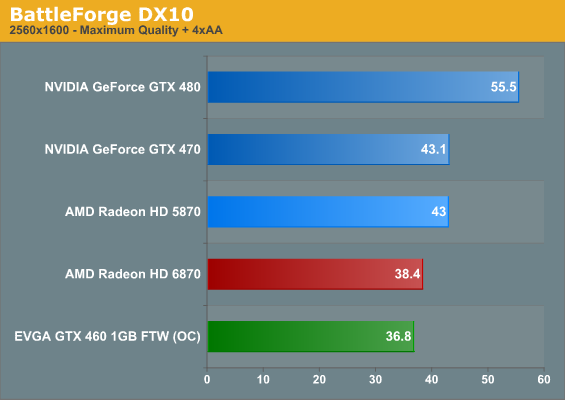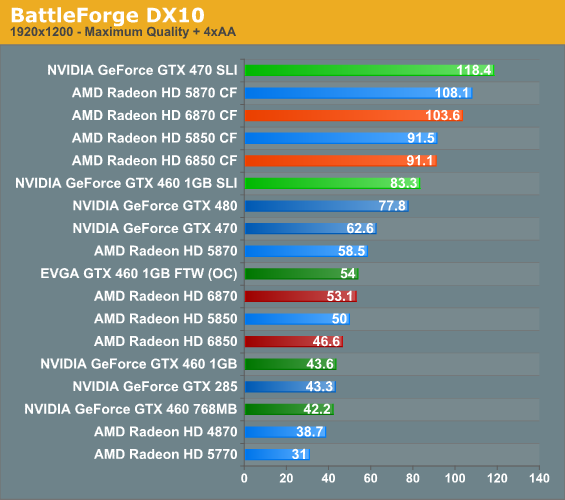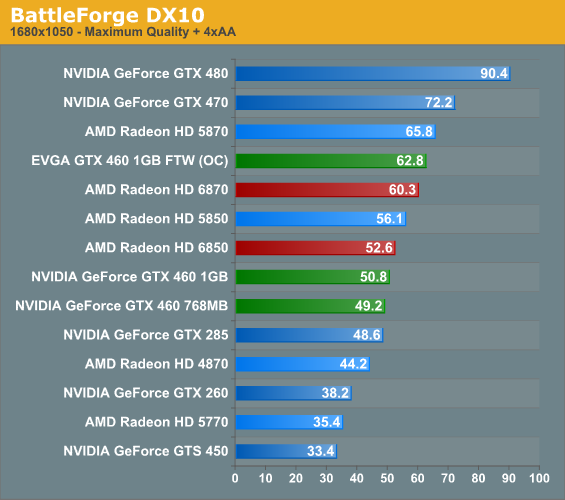AMD’s Radeon HD 6870 & 6850: Renewing Competition in the Mid-Range Market
by Ryan Smith on October 21, 2010 10:08 PM ESTUp next is BattleForge, Electronic Arts’ free to play online RTS. As far as RTSes go this game can be quite demanding, and this is without the game’s DX11 features.



Unlike Crysis, BattleForge delivers distinctly different results. The GTX 470 is the clear winner by nearly 15%, while the EVGA GTX 460 and the 6870 are neck-and-neck. Meanwhile the 6850 takes a convincing lead over the stock-clocked GTX 460s. Both 6800 series cards end up falling where we would expect them to, splitting either side of the 5850 and falling behind the 5870.
Meanwhile we once more see unusual Crossfire results; the 6800 series doesn’t beat the 5800 series this time, but it once again closes the gap left by the individual cards.










197 Comments
View All Comments
Chris Peredun - Friday, October 22, 2010 - link
Not bad, but consider that the average OC from the AT GTX 460 review was 24% on the core. (No memory OC was tried.)http://www.anandtech.com/show/3809/nvidias-geforce...
thaze - Friday, October 22, 2010 - link
German magazine "PC Games Hardware" states the 68xx need "high quality" driver settings in order to reach 58xx image quality. Supposedly AMD confirmed changes regarding the driver's default settings.Therefore they've tested in "high quality" mode and got less convincing results.
Details (german): http://www.pcgameshardware.de/aid,795021/Radeon-HD...
Ryan Smith - Friday, October 22, 2010 - link
Unfortunately I don't know German well enough to read the article, and Google translations of technical articles are nearly worthless.What I can tell you is that the new texture quality slider is simply a replacement for the old Catalyst AI slider, which only controlled Crossfire profiles and texture quality in the first place. High quality mode disables all texture optimizations, which would be analogous to disabling CatAI on the 5800 series.So the default setting of Quality would be equivalent to the 5800 series setting of CatAT Standard.
thaze - Saturday, October 30, 2010 - link
"High quality mode disables all texture optimizations, which would be analogous to disabling CatAI on the 5800 series.So the default setting of Quality would be equivalent to the 5800 series setting of CatAT Standard. "According to computerbase.de, this is the case with Catalyst 10.10. But they argue that the 5800's image quality suffered in comparison to previous drivers and the 6800 just reaches this level of quality. Both of them now need manual tweaking (6800: high quality mode; 5800: CatAI disabled) to deliver the Catalyst 10.9's default quality.
tviceman - Friday, October 22, 2010 - link
I would really like more sites (including Anandtech) to investigate this. If the benchmarks around the web using default settings with the 6800 cards are indeed NOT apples to apples comparisons vs. Nvidia's default settings, then all the reviews aren't doing fair comparisons.thaze - Saturday, October 30, 2010 - link
computerbase.de also subscribes to this view after having invested more time into image quality tests.Translation of a part of their summary:
" [...] on the other hand, the textures' flickering is more intense. That's because AMD has lowered the standard anisotropic filtering settings to the level of AI Advanced in the previous generation. An incomprehensible step for us, because modern graphics cards provide enough performance to improve the image quality.
While there are games that hardly show any difference, others suffer greatly to flickering textures. After all, it is (usually) possible to reach the previous AF-quality with the "High Quality" function. The Radeon HD 6800 can still handle the quality of the previous generation after manual switching, but the standard quality is worse now!
Since we will not support such practices, we decided to test every Radeon HD 6000 card with the about five percent slower high-quality settings in the future, so the final result is roughly comparable with the default setting from Nvidia."
(They also state that Catalyst 10.10 changes the 5800's AF-quality to be similar to the 6800's, both in default settings, but again worse than default settings in older drivers.)
Computer Bottleneck - Friday, October 22, 2010 - link
The boost in low tessellation factor really caught my eye.I wonder what kind of implications this will have for game designers if AMD and Nvidia decide to take different paths on this?
I have been under the impression that boosting lower tessellation factor is good for System on a chip development because tessellating out a low quality model to a high quality model saves memory bandwidth.
DearSX - Friday, October 22, 2010 - link
Unless the 6850 overclocks a good 25%, what 460s reference 460s seem to overclock on average, it seems to not be any better overall to me. Less noise, heat, price and power, but also less overclocked performance? I'll need to wait and see. Overclocking a 460 presents a pretty good deal at current prices, which will probably continue to drop too.Goty - Friday, October 22, 2010 - link
Did you miss the whole part where the stock 6870 is basically faster (or at worst on par with) the overclocked 460 1GB? What do you think is going to happen when you overclock the 5870 AT ALL?DominionSeraph - Friday, October 22, 2010 - link
The 6870 is more expensive than the 1GB GTX 460. Apples to apples would be DearSX's point -- 6850 vs 1GB GTX 460. They are about the same performance at about the same price -- $~185 for the 6850 w/ shipping and ~$180 for the 1GB GTX 460 after rebate.The 6850 has the edge in price/performance at stock clocks, but the GTX 460 overclocks well. The 6850 would need to consistently overclock ~20% to keep its advantage over the GTX 460.